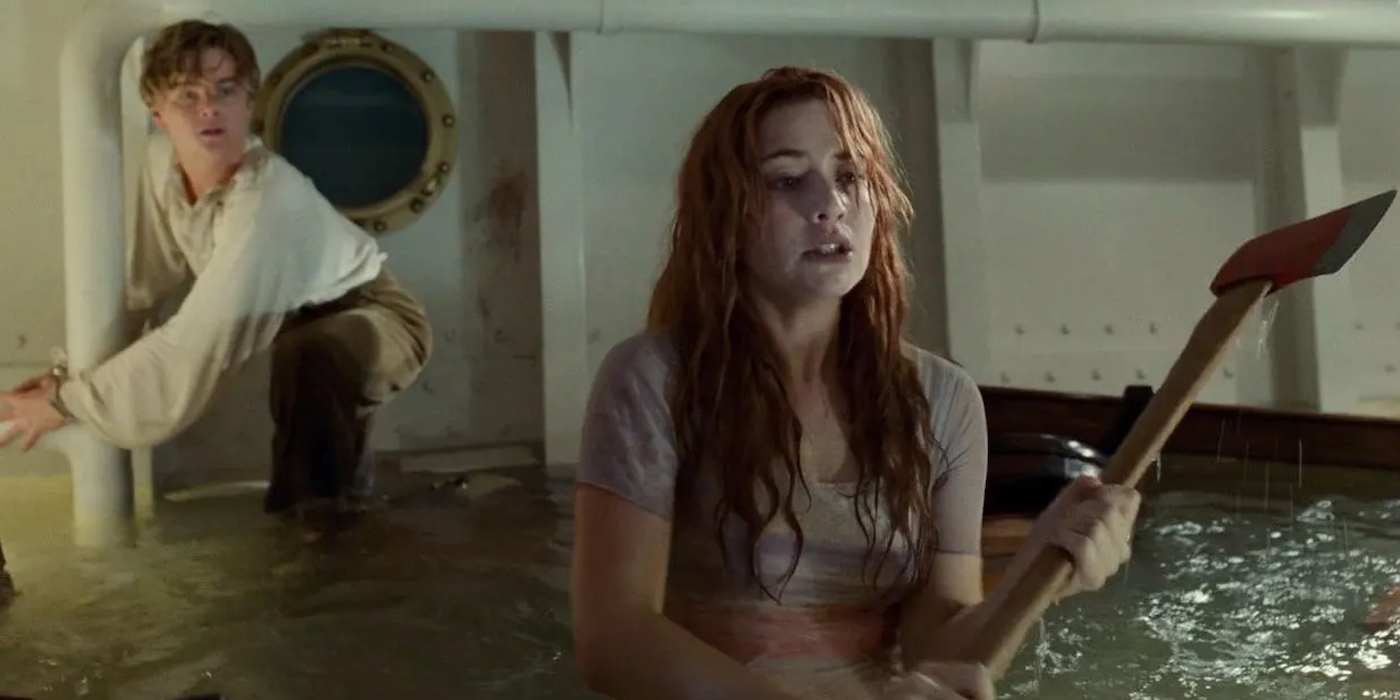
With a film as grand and operatic as Titanic, viewers always find new things to analyze upon repeat viewing. Throughout late 1997 and early 1998, practically the entire world saw James Cameron’s romantic disaster epic multiple times in theaters. The former holder of the #1 highest-grossing movie of all time was the quintessential four-quadrant vehicle, offering something for everyone of all genders and ages: history, action, and romance. Despite its massive scope and 3-hour runtime, Titanic focuses on minor details and subtle nuances to round out the story. One brief moment, the sequence when a passenger jumps off the sinking titular ship and crashes into a propeller during his fall, is one of the most memorable. However, you probably didn’t know that the individual who meets a brutal fate, colloquially known as the “Propeller Guy,” was modeled after one of the film’s producers.

‘Titanic’ Was a Near-Disastrous Production
For James Cameron and his cast and crew, any result less than the most successful film of all time would’ve felt like a grave underachievement. Titanic’s ambitious production was unparalleled, but the weight of the production looked like it was about to collapse under its own ambition. Filming went over budget and behind schedule, and Cameron’s daring underwater escapade could’ve jeopardized the safety of his cast and crew. The press was eager to pounce on Titanic as the next great Hollywood fiasco akin to Heaven’s Gate or Waterworld. As Cameron habitually does, he proved the naysayers wrong when Titanic sailed to the top of the box office and the Academy Awards, earning well over a billion dollars worldwide and 11 Academy Awards, including Best Director (when Cameron controversially announced himself as the “king of the world”) and Best Picture. It was the highest-grossing film of all time until Cameron topped himself with Avatar.

Blood, sweat, and tears were poured into the production of this cultural phenomenon about two star-crossed lovers, Jack Dawson (Leonardo DiCaprio) and Rose DeWitt (Kate Winslet) on an ill-fated cruise ship. With Cameron, notorious for his dictatorial presence on set, barking commands and submerging the set underwater, laughs and smiles were likely few and far between. Luckily, for the visual effects department, they found an unexpected source of levity. The extended ship-sinking sequence is a masterclass in constructing an epic set piece. The destruction feels tangible, and Cameron blocks the action and ship geography with incredible precision. He shoots the action with a visceral edge without undermining the tragic undertones of the story.
Through Advanced Digital Technology, the Propeller Guy Was Modeled After Jon Landau
Amid hundreds of extras and locations, Cameron sprinkles numerous indelible moments throughout the sequence, such as the violin players attempting to alleviate the panic and Rose breaking Jack’s handcuffs with an ax, but none have quite the staying power like the fateful Propeller Guy. With the deboarding process completely gone by the wayside, panic escalates. Desperate passengers see no other option than to dive into the freezing water. Many have perched on the ship’s deck, the last remaining dry area. While trying to hold on to the deck, a man falls and plummets towards the water, but in a brutal stroke of misfortune, during his free-fall, he collides into one of the ship’s propellers, which sends his body pinwheeling. Weaker directors could have choreographed the sinking, but only the great ones like Cameron can dramatize isolated moments to express the chaos and horror of this scenario. The propeller crash, while harrowing, provides perverse black humor, as the timing and sound effect of the Propeller Guy’s demise evoke a stunt from a slapstick comedy.

VFXblog, a blog dedicated to special effects across all mediums, wrote an extensive history of the Propeller Guy scene and how it manifested. The site interviewed Titanic’s visual effects supervisor, Rob Legato, and he revealed a stunning piece of information about the iconic sequence. While indistinguishable to the viewer’s eye, Legato, through digital technology, modeled the Propeller Guy off ofJon Landau, the film’s producer and James Cameron’s long-running producing partner. Cameron, a visual genius who ushered in advanced digital effects in Terminator 2: Judgment Day, seamlessly shifted digital and old-school practical effects when making Titanic. Computer-generated images were deployed sporadically, notably to render rough outlines of people’s faces on the ship. To create faces for the digital extras, the VFX team scanned the faces of real people and attached them to the digital renderings. Along with working on the Avatar films, Landau has also co-produced films with Cameron that he did not direct, including Steven Soderbergh’s Solaris and Alita: Battle Angel.
